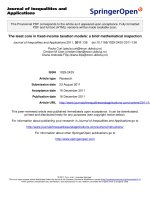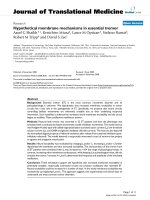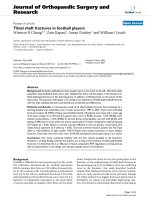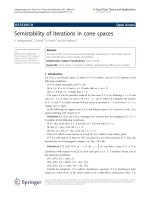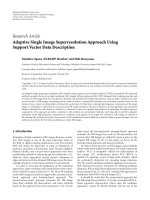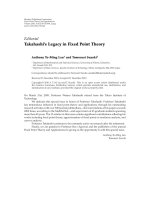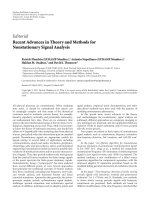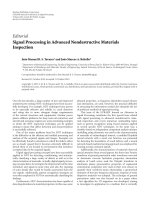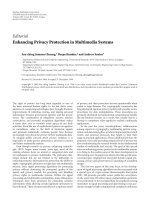Báo cáo hóa học: " Editorial Machine Learning in Image Processing" pot
Bạn đang xem bản rút gọn của tài liệu. Xem và tải ngay bản đầy đủ của tài liệu tại đây (427.14 KB, 2 trang )
Hindawi Publishing Corporation
EURASIP Journal on Advances in Signal Processing
Volume 2008, Article ID 927950, 2 pages
doi:10.1155/2008/927950
Editorial
Machine Learning in Image Processing
Olivier L
´
ezoray,
1
Christophe Charrier,
1
Hubert Cardot,
2
and S
´
ebastien Lef
`
evre
3
1
GREYC, UMR CNRS 6072, ENSICAEN, Universit
´
e de Caen Basse-Normandie,
6BoulevardduMar
´
echal Juin, 14050 Caen cedex, France
2
Pattern Recognition and Image Analysis Team, Computer Science Laboratory (LI), Universit
´
eFranc¸ois Rabelais de Tours,
64 avenue Jean Portalis, 37200 Tours, France
3
Models Images Vision (MIV) Team, Image Sciences, Computer Scie nces and Remote Sensing Laboratory (LSIIT),
Universit
´
e Louis Pasteur de Strasbourg, P
ˆ
ole API, Bd. Brant, BP 10413, 67412 Illkirch, France
Correspondence should be addressed to Olivier L
´
ezoray,
Received 29 May 2008; Accepted 29 May 2008
Copyright © 2008 Olivier L
´
ezoray et al. This is an open access article distributed under the Creative Commons Attribution
License, which permits unrestricted use, distribution, and reproduction in any medium, provided the original work is properly
cited.
1. BACKGROUND AND MOTIVATION
Images have always played an important role in human
life since vision is probably human beings’ most important
sense. As a consequence, the field of image processing has
numerous applications (medical, military, etc.). Nowadays
and more than ever, images are everywhere and it is very
easy for everyone to generate a huge amount of images,
thanks to the advances in digital technologies. With such a
profusion of images, traditional image processing techniques
have to cope with more complex problems and have to face
their adaptability according to human vision. With vision
being complex, machine learning has emerged as a key
component of intelligent computer vision programs when
adaptation is needed (e.g., face recognition). With the advent
of image datasets and benchmarks, machine learning and
image processing have recently received a lot of attention.
An innovative integra tion of machine learning in image
processing is very likely to have a great benefit to the field,
which will contribute to a better understanding of com-
plex images. The number of image processing algorithms
that incorporate some learning components is expected to
increase, as adaptation is needed. However, an increase in
adaptation is often linked to an increase in complexity, and
one has to efficiently control any machine learning technique
to properly adapt it to image processing problems. Indeed,
processing huge amounts of images means being able to
process huge quantities of data often of high dimensions,
which is problematic for most machine learning techniques.
Therefore, an interaction with the image data and with image
priors is necessary to drive model selection strategies.
The primary purpose of this special issue is to increase
the awareness of image processing researchers to the impact
of machine learning algorithms. The special issue discusses
problems and their proposed solutions currently under
research by the community. In the opinion of the guest
editors, the scope of this special issue covers a broad range
of machine learning potentials for image processing.
2. QUICK FACTS ABOUT THE SPECIAL ISSUE
The guest editors suggested putting together this special issue
on machine learning in image processing to the editor-in-
chief in November 2006. In May 2007, the guest editors and
the editor-in-chief established the outline and schedule of
the special issue, and the first call for papers was distributed
through the Internet.
Between May and October 2007, 30 manuscripts were
submitted for review and possible inclusion in the special
issue.
Experts in the fields of machine learning and image
processing reviewed each of the submitted manuscripts.
After two rounds of rigorous reviews between N ovember
2007 and February 2008, 14 papers were finally accepted for
inclusion in the special issue.
3. SCANNING THE SPECIAL ISSUE
This special issue attempts to provide a comprehensive
overview of the most recent trends in machine learning in
image processing. The papers included in the issue focus
on various topics. Accepted papers cover both theoretical
2 EURASIP Journal on Advances in Signal Processing
and practical aspects of face and vehicle detection, manifold
and image processing, multiresolution and multisource, and
morphological processing. We org anized the special issue
around these topics.
Face and vehicle detection
Thespecialissueopenswithfivepapersonfaceandvehicle
recognition/detection.
In their paper, “Face recognition using classification-
based linear projections,” J. Goldberger and M. Butman
propose a face recognition algorithm based on a linear
subspace projection with neighbourhood component anal-
ysis and performance criterion to obtain the optimal linear
projection.
In their paper entitled “Kernel learning of histogram
of local Gabor phase patterns for face recognition,” B.
Zhang et al. propose a face recognition algor ithm based on
Daugman’s method for iris recognition and the local XOR
pattern operator along with kernel discriminant analysis.
In the paper entitled “Face retrieval based on robust
local features and statistical-structural learning approach,” I.
Defee and D. Zhong propose a framework for the unification
of statistical and structural information for pattern retrieval
based on local feature sets.
In their paper, “DOOMRED: a new optimization tech-
nique for boosted cascade detectors on enforced training
set,” K. M. Lee and D. W. Park propose a new method to
optimize the completely trained b oosted cascade detector on
an enforced training set.
In the next paper, “A cascade of boosted generative
and discriminative classifiers for vehicle detection,” P. Negri
et al. propose an algorithm for the onboard vision vehicle
detection problem using a cascade of boosted classifiers.
Manifold and image processing
The special issue continues with four papers on the process-
ing of manifolds and images.
In their paper, “A metric multidimensional scaling-based
nonlinear manifold learning approach for unsupervised data
reduction,” C. Heinrich et al. propose a nonlinear extension
to PCA for manifold learning that makes use of compression
and regression along with a Bayesian projection procedure
for out-of-sample extension.
In their paper, “An adaptively accelerated Bayesian
deblurring method with entropy prior,” M. K. Singh et al.
propose a method for image deblurring that uses a multi-
plicative correction term and has been calculated using an
exponent on the correction factor.
In the paper entitled “Iterative estimation algorithms
using conjugate funct ion lower bound and minorization-
maximization with applications in image denoising,” G.
Deng and W Y. Ng propose a generalized algorithm for
wavelet domain image denoising by solving the MAP
estimation problems under a linear Gaussian observation
model.
In the next paper entitled “A practical approach for
simultaneous estimation of light source position, scene
structure, and blind restoration using photometric obser-
vations,” S. Sharma and M. Joshi propose an algorithm for
photometric stereo that provides light source position and
scene structure, and performs blind restoration with given
observations.
Multiresolution and multisource analysis
The special issue continues with three papers making use of
the multiresolution or multisource paradigms.
In their paper, “Learning how to extract rotation-inva-
riant and scale-invariant features from texture images,” J. A.
Montoya-Zegarra et al. propose a texture recognition system
based on steerable pyramid decomposition and optimum
path forest recognition.
In the next paper, “Multiresolution image parametriza-
tion for improving texture classification,” L.
ˇ
Sajn and I.
Kononenko present an automatic image parameterization
on multiple resolutions, based on texture description with
specialized association rules, and image e valuation with
machine learning methods.
In their paper, “Multisource images analysis using collab-
orative clustering,” G. Forestier et al. propose a collaborative
system for image clustering by obtaining a consensus among
several clusterings that exploit heterogeneous images.
Morphological processing
The special issue ends with two papers on morphological
processing for segmentation and compression.
In their paper entitled “Heterogeneous stacking for
classification-driven watershed segmentation,” I. Levner
et al. show how to design an automated segmentation system
by utilizing automated feature extraction in conjunction with
heterogeneous stacking for a watershed process.
Finally, in the paper entitled “Morphological transform
for image compression,” O. Pogrebnyak et al. present a
method for image compression based on morphological
associative memories.
ACKNOWLEDGMENTS
The guest editors thank all of those who have helped to
make this special issue possible, especially the authors and
the reviewers of the articles. They thank the editorial staff
for the help and support in managing the issue, and finally
gratefully acknowledge the Editor-in-Chief for giving them
the opportunity to edit this s pecial issue.
Olivier L
´
ezoray
Christophe Charrier
Hubert Cardot
S
´
ebastien Lef
`
evre
